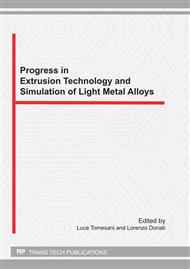p.197
p.205
p.215
p.223
p.233
p.241
p.249
p.257
p.265
Simulation of the Grain Structure Evolution of a Mg-Al-Ca-Based Alloy during Hot Extrusion Using the Cellular Automation Method
Abstract:
In the present study, the evolution of the grain structure of a Mg-Al-Ca-based alloy during hot extrusion was simulated with the cellular automation method. The Laasraoui-Jonas microstructure model was used to describe the dislocation evolution inside crystallites during dynamic recrystallization. The parameters in the Laasraoui-Jonas model, such as the hardening parameter, recovery parameter and material constants, were determined from the flow stress-strain data obtained from hot compression tests using a Gleeble-1500 thermomechanical simulator. The extrusion process was simulated using a DEFORM 3D FEM code. The influence of ram speed on grain structure evolution was analyzed. It was found that the average grain size increases with increasing ram speed. Good agreements between the predicted and observed grain structures were achieved.
Info:
Periodical:
Pages:
265-272
Citation:
Online since:
September 2011
Keywords:
Price:
Сopyright:
© 2012 Trans Tech Publications Ltd. All Rights Reserved
Share:
Citation:


